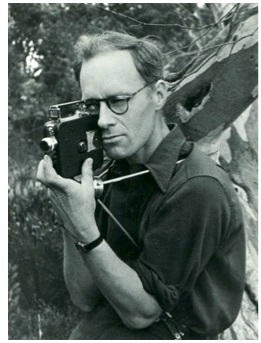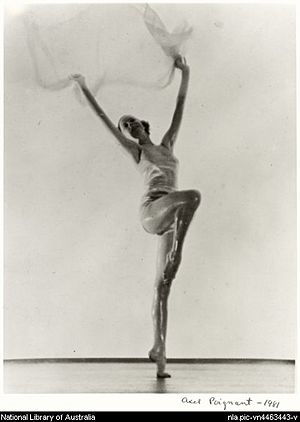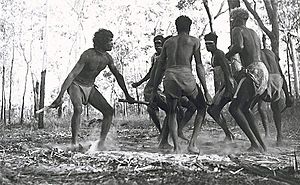Axel Poignant facts for kids
Quick facts for kids
Axel Poignant
|
|
|---|---|

Self-portrait with first movie camera, Perth, 1933-34
|
|
| Born | 12 December 1906 |
| Died | 5 February 1986 |
| Nationality | Australian |
| Known for | Photography |
| Spouse(s) | Sandra St Lucien Eliot Chase, 1930-1941 (div.) Ruth Marjorie Pettersen, 1942-1953 (her death) Roslyn Betty Izatt, 1953-1986 (his death) |
Axel Poignant (born December 12, 1906 – died February 5, 1986) was a famous Australian photographer. He was known for his unique way of capturing people and nature.
Contents
Axel Poignant's Life Story
Axel Poignant was born in Leeds, England, in 1906. His father was Swedish, and his mother was English. He had a younger brother. Axel went to school in England and then moved to Sweden in 1918 to finish his education.
In 1925, he returned to England. The next year, in July 1926, he moved to Sydney, New South Wales, Australia. He came to Australia as part of the Dreadnought Scheme. This program helped young men from England find work in Australia. Axel traveled around Sydney and New South Wales looking for jobs.
In 1930, Axel married Sandra St Lucien Eliot Chase. They moved to Perth, Western Australia. There, Axel started taking photos of people and special events. He also took pictures from airplanes for a mining company. Axel and Sandra later separated in 1941.
Axel became an Australian citizen in 1942. In the same month, he married Ruth Marjorie Pettersen. He joined the Australian Army the next year. He left the army in 1945.
Sadly, his second wife, Ruth, passed away in 1953. Later that year, Axel married Roslyn Betty Izatt in Sydney. Roslyn was also a film technician. They had known each other since 1950. They were partners in life and in their photography work.
In 1956, Axel and Roslyn moved to England. Axel Poignant passed away at his home in Lewisham, London, in 1986.
His Amazing Photography Work
Axel Poignant became very interested in photography after moving to Perth in 1930. He bought a special camera called a Leica in 1933. He started by taking portraits, which are pictures of people.
Axel and another photographer, Stuart Gore, opened a studio in London. They worked on taking aerial photos of gold mining areas in Western Australia. Axel's photos were fresh and new. He used interesting angles and techniques. For example, he took pictures of logging in Pemberton in 1935. He also photographed the mines in Kalgoorlie in 1936. His aerial views of the Duke of Gloucester arriving in Perth in 1934 were also very popular. He even captured the Anzac Day dawn service in Perth in 1939.
Axel also took photos of dancing and theatre. He worked with Linley Wilson, who ran a dance studio. After setting up his own studio, more people saw his photos. He became interested in natural history and telling stories through pictures.
In 1941, he had an exhibition in Perth with Hal Missingham. The next year, he traveled along the Canning Stock Route. He took photos that changed how Indigenous Australians were shown.
Axel Poignant's photos often showed Australian traditions and Indigenous culture. Many of his pictures captured the plants and animals of The Outback. He wanted his photos to show "real humanity." He built strong friendships with Indigenous people during his travels. He continued to take portraits of them and their daily lives.
Axel used special angles in his photos. He would often shoot from a low viewpoint or very close up. This made his pictures look more natural. It was different from earlier ways of photographing people, which were often very sharp and formal.
Books by Axel Poignant
Axel Poignant also created books with his photographs.
- Piccaninny Walkabout, published in 1957, was a very special book. It won the Children's Book Council of Australia Picture Book Children's Book of the Year Award in 1958. The book tells the story of two Aboriginal children, Nullagundi and Rikili, who go on a walkabout.
- Kaleku (1972) with Roslyn Poignant
- Children of Oropiro (1976) with Roslyn Poignant
- Encounter at Nagalarramba (1996) was a book he worked on with Roslyn Poignant.
Exhibitions of His Work
Axel Poignant's photographs have been shown in many exhibitions. This allows people to see his amazing work.
In 1986, his work was part of an exhibition called Aspects of Post Modernism 1929-1942. This show was held at the University of Western Australia.
In September 1941, Axel and Hal Missingham had an exhibition together. They each showed fifty photographs. They also gave talks about their work.
A special series of exhibitions called "Poignant's Retrospective" took place in 1982. These shows displayed photos he had taken from 1922 to 1980. The Art Gallery of New South Wales helped organize these exhibitions.
The 1982 exhibition at the NSW Art Gallery showed 107 photographs. This exhibition then traveled to different states in Australia.
In 1982, the Art Gallery of Western Australia also hosted an exhibition. It featured Poignant's photos of Kalgoorlie, the Canning Stock Route, and Central Australia.
In 1983, the National Gallery of Victoria held an exhibition of his work. The Tasmanian Museum and Art Gallery also showed his photographs in 1983. This exhibition was described as a major look at his work. It highlighted his reputation for showing Australian life, especially the lives of Indigenous Australians.
After Axel Poignant passed away, important places like the National Library of Australia in Canberra, and the art galleries of Western Australia and New South Wales, collected his work.
In 2007, the Art Gallery of New South Wales had an exhibition focusing on his "Indigenous Connections." The Australian National Portrait Gallery also has many of his photographs in its collection.
See Also
- Roslyn Poignant



